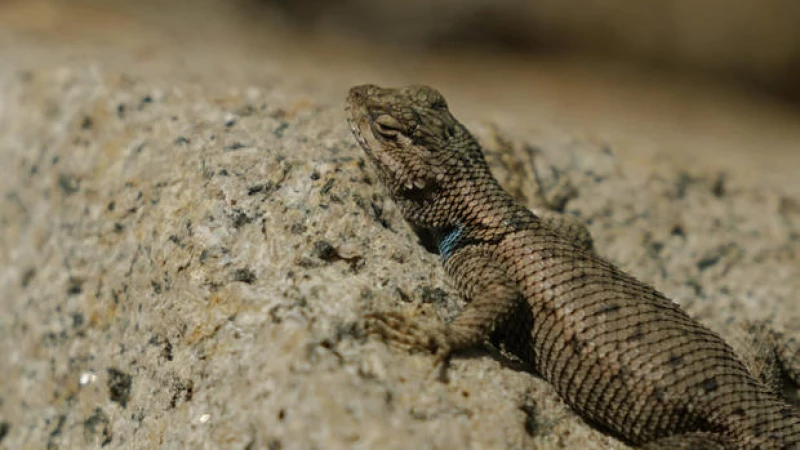BISBEE, Ariz. — Boots dusty, lungs heaving, Dr. John Wiens searched the boulders of a desolate Arizona mountaintop for the last survivors of a 3-million-year-old lizard population — then said the words that both confirmed his life's work and broke his heart.
"They're not there," he said. "It seems like the species is now extinct."

The loss of plant and animal species on Earth is happening at a speed never seen in human history, according to the United Nations. That includes the likely extinction of the lizards Wiens has studied for 10 years — the population of Yarrow's spiny lizards found in the Mule Mountains of southern Arizona.
"There's a lot of species on Earth, and we're going to lose a lot of them because of climate change," said Weins, an evolutionary biologist at the University of Arizona. "It's catastrophic."

Riding the elevator to extinction
Over the last 3 million years — a million years longer than humans have been around — the Yarrow's spiny lizards in the Mules adapted to live in cool mountain climates called sky islands.
The Tragic Plight of the Yarrow's Spiny Lizards
Trapped at high elevations like castaways on an island, the Yarrow's spiny lizards found themselves isolated due to scorching desert temperatures below. This separation from other populations in Arizona and Mexico spelled doom for these creatures.
Unlike many other species, these lizards were easily spotted in the wild, basking in the sun on rocky outcrops. This behavior allowed researchers to monitor their numbers and study the impact of climate change on their population.
In 2014, a grim discovery was made as no lizards were found below 5,700 feet. The rising temperatures had forced them to higher ground. Upon returning in 2021-22, researchers found the lizards missing from their usual spot.
"They're dying at lower elevations," lamented one of the researchers.
Now confined to 7,100 feet, the lizards faced a rapid decline in numbers. Scientists, in a published paper, revealed the alarming rate at which the population was dwindling. With the highest peak in the area at 7,700 feet, the lizards had little room to escape the heat.
Based on projections, the Yarrow's spiny lizards were on a fast track to extinction by 2025, a phenomenon ominously referred to as "riding the elevator to extinction."
Source: Scientific Paper
In March of this year, a journey into the mountains with CBS News confirmed his theory, one year earlier than expected. Wiens was unable to locate any lizards, but further expeditions are needed to draw a final conclusion.
"It appears that the species has now vanished, this unique lineage that has been isolated for approximately 3 million years," he remarked. "This is a glimpse into the future. This is extinction driven by climate change."
As per Krista Kemppinen, a senior scientist at the Center for Biological Diversity, who was not involved in Wiens' study, the consequences are severe for other species in the Sonoran Desert, where the Mules are situated, as they might already be reaching their limit in terms of heat tolerance.
"The area is essentially a time bomb in the face of climate change," she warned.
Humans "bear some responsibility for this"
As per a comprehensive 2019 U.N. report, 1 million plant and animal species are facing extinction worldwide.
Wiens suggested that the actual number is likely much higher in a recent research paper he authored in Global Change Biology. He predicts that between 3 to 6 million species will be at risk of extinction in the next 50 years, primarily due to climate change making the environment too warm for many species to survive.
"As human beings, in the developed world, we all sort of have some responsibility for this," Wiens said.
While the distinct 3-million-year-old population of Yarrow's lizard species is presumed extinct in the Mule Mountains, its distant relatives still exist in other mountainous locations in Arizona and Mexico — though many are also in decline.
Still, across the country, 1,700 plants and animals are listed as threatened or endangered under the Endangered Species Act, which provides resources to help protect the species and their habitat.
The act is widely viewed as an environmental success story. Some high-profile species on the list include:
-
The California condor, the largest flying bird in the U.S., with about 90 adults remaining in the wild.
-
The iconic Florida panther, with about 200 animals remaining.
-
The massive North Atlantic right whale, which roams the Atlantic Ocean; all that's left are 250 individuals.
Still, the Endangered Species Act only covers a fraction of the species at risk, in part because the process of listing a species can be long, bureaucratic and political.
"It can take on average 12 years, when legally it should only take two," Kemppinen said.
Not enough time for the Yarrow's spiny lizards of the Mule Mountains.







